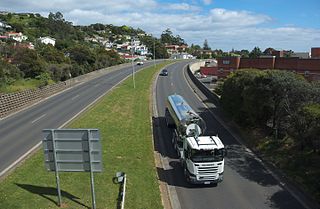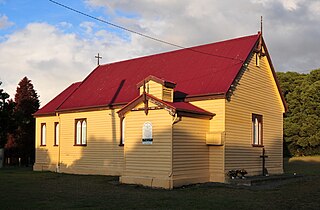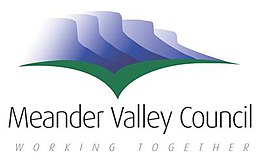Councils of Tasmania are the 29 administrative districts of the Australian state of Tasmania. Local government areas (LGAs), more generally known as councils, are the tier of government responsible for the management of local duties such as road maintenance, town planning and waste management.

Derwent Valley Council is a local government body situated in southern-central Tasmania, west of Hobart. Derwent Valley is classified as a rural local government area and has a population of 10,021, it includes the localities of Bushy Park, Maydena and Strathgordon, with New Norfolk the major, principal town.
West Tamar Council is a local government body in Tasmania, situated along the western side of the Tamar River in the north of the state. West Tamar is classified as an urban local government area and has a population of 22,718, it extends from the outer reaches of north-west Launceston and includes the towns and localities of Beaconsfield, Beauty Point and Legana.

Northern Midlands Council is a local government body in Tasmania, extending south of Launceston into the northern region of the Tasmanian central midlands. Northern Midlands is classified as a rural local government area and has a population of 12,822, the major population centres and localities of the region include Campbell Town, Evandale, Longford, and Perth.

Deloraine is a town on the Meander River, in the central north of Tasmania, Australia. It is 50 km west of Launceston and 52 km south of Devonport along the Bass Highway. It is part of the Meander Valley Council. As of 2011, the town of Deloraine had a population of 2,745

The Bass Highway is a highway in Tasmania, Australia. It is a part of the National Highway, designated as National Highway 1 and connects the major cities across the north of the state - Burnie, Devonport and Launceston. The road was named due to its proximity to the Bass Strait.

Westbury is a town in the central north of Tasmania, Australia. It lies 30 km west of Launceston on the Bass Highway, and at the 2016 census had a population of approximately 2,000. It is part of, and the headquarters of, the Meander Valley Council area.

Meander is a rural town in the Meander Valley Council area of northern Tasmania, Australia. In 2001 it had a population of 415, forty percent of whom worked directly in agriculture, many in the dominant industries of grazing of sheep and cattle, and the dairy industry. The surrounding land has been modified by the original Indigenous inhabitants, who turned forest into grassland, and the later settlers, who have created extensive channels for irrigation and drainage. The town is 24 kilometres (15 mi) south of the town of Deloraine, Tasmania and is bisected by the Meander River. It sits between Quamby Bluff and Mother Cummings Peak of the Great Western Tiers mountain range.

Caveside is a rural locality in Northern Tasmania, lying between the Great Western Tiers to the south and Mole Creek to the north.

Mole Creek is a town in the upper Mersey Valley, in the central north of Tasmania, Australia. Mole Creek is well known for its honey and accounts for about 35 percent of Tasmania's honey production.
George Town Council is a local government body in northern Tasmania, situated north of Launceston. The George Town local government area is classified as rural and has a population of 6,754, it encompasses the principal town, George Town, and the nearby localities including Hillwood, Low Head and Pipers River.

Launceston City Council is a local government body in Tasmania, located in the city and surrounds of Launceston in the north of the state. The Launceston local government area is classified as urban and has a population of 65,274, which also encompasses the localities including Lilydale, Targa and through to Swan Bay on the eastern side of the Tamar River.

Hagley is a town in Northern Tasmania, Australia, 22 kilometres (14 mi) southwest of Launceston on the Meander Valley Highway. The area was used by the Port Dalrymple—an early name for George Town in Northern Tasmania—Aboriginal Tasmanians until they were driven from their lands by European settlement. Land grants from the 1820s, to William Thomas Lyttleton, William Bryan and Sir Richard Dry, led to the first buildings, and later gazetting of the town in April 1866. Lyttleton was associated with Hagley Hall in England; his naming of his estate led to the town's name, and he is believed to have bequeathed the town's land. Hagley is an agricultural centre sited on largely alluvial soil near the Meander River. As of 2011, the town had a population of 330, most of whom were Australian born. Hagley is remembered as the first site of coursing in Tasmania, which started at Quamby Estate in 1878. The town has had cricket and Australian rules football teams, but it no longer fields teams.

Birralee is a locality and small rural settlement in the local government area of Meander Valley, in the Launceston region of Tasmania. It is located about 20 kilometres (12 mi) north of the town of Westbury. Black Sugarloaf Creek, a tributary of the Meander River, forms part of the southern boundary, and part of the eastern boundary runs parallel to Four Springs Creek. The 2016 census determined a population of 182 for the state suburb of Birralee.

Weetah is a locality and small rural community in the local government area of Meander Valley, in the Launceston region of Tasmania. It is located about 11 kilometres (6.8 mi) north of the town of Deloraine. The 2016 census determined a population of 44 for the state suburb of Weetah.

Red Hills is a locality and suburb in the local government area of Meander Valley, in the Launceston region of Tasmania. It is located about 7 kilometres (4.3 mi) west of the town of Deloraine. The Meander River forms part of the south-eastern boundary, while its tributary Western Creek forms the remainder. The railway tracks of the Western line pass through the north-eastern corner of the locality, crossing the B12 route at Lemana Junction. The 2016 census determined a population of 120 for the state suburb of Red Hills.

Parkham is a locality and small rural community in the local government area of Meander Valley, in the Launceston region of Tasmania. It is located about 24 kilometres (15 mi) north of the town of Deloraine. The 2016 census determined a population of 129 for the state suburb of Parkham.

Bridgenorth is a locality and small rural community in the local government area of West Tamar, in the Western Tamar Valley region of Tasmania. It is located about 22 kilometres (14 mi) north-west of the town of Launceston. A small part of the locality is in the Meander Valley Council area. The 2016 census determined a population of 373 for the state suburb of Bridgenorth.
















